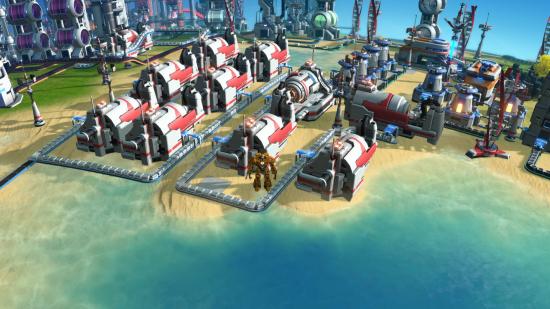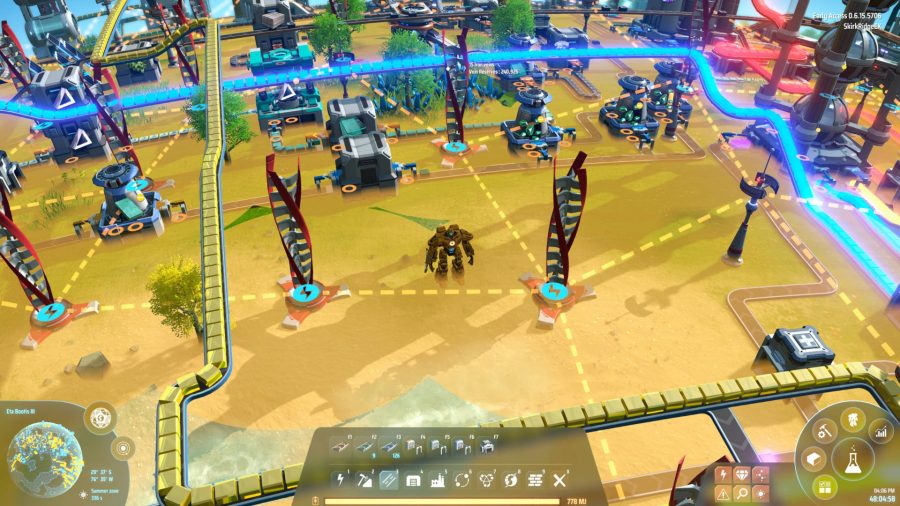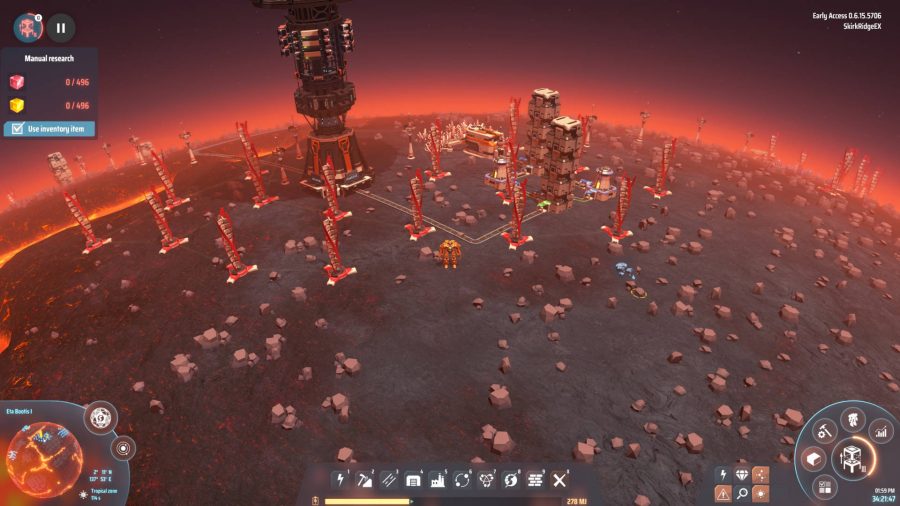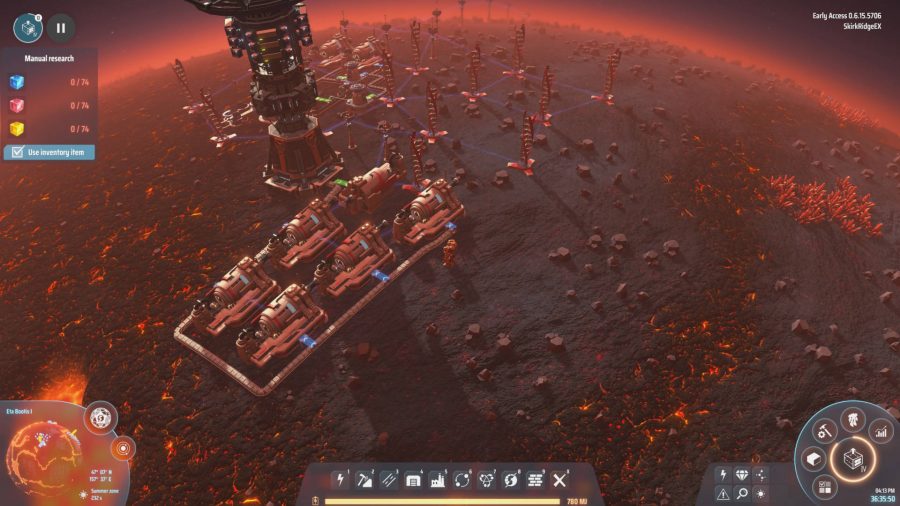One of the trickier things to get running efficiently in Dyson Sphere Program is power management. It doesn’t help that the game takes it relatively easy on you in the beginning, with wind turbines more than meeting energy demand for the most basic buildings. Even powering your mech is easy in the beginning as you can just bundle in coal to keep it running until you engineer ways to easily get better resources.
Soon though you may run into some issues: buildings working slower than originally intended, resources not appearing, running out of energy on your mech whilst floating on a gas giant, that sort of thing. Chances are that if there’s nothing wrong with the production line, the problem is that you don’t have enough power available to keep everything running smoothly.
So to keep your base running as smoothly as is possible, you need to learn all about how each resource generates energy, how to transfer power between planets, and which of the many energy resources are the most efficient.
How the Dyson Sphere Program power grid works
Managing power on every planet is a tricky business. There are many factors to consider, such as how much coal or oil there is on the planet, or the wind and solar energy ratios. When you’ve unlocked the ability to look at the starmap, press V to get a view of the nearest planets. By zooming out, then clicking on the planet you wish to view the details of, you can see the potential energy that planet can produce.
In addition to learning about each individual planet, you’ll need to ensure that your base is running at optimal power levels. If you go to the bottom right corner of the screen and click the button with four squares, you can open up a menu that allows you to toggle UI displays.
The lightning bolt is your current power level and it’s shown as colour coded circles on the ground by your power sources. If it’s red, you don’t have enough power to operate your base. If it’s amber, buildings will run but you may need to construct more energy facilities as they will run at reduced speed. Blue rings indicate that the base is running at full power.
Dyson Sphere Program power stations explained
When you begin the game, the only power sources available to you are the wind turbines. They’re good enough for the beginning of the game, but pretty soon you’ll want to upgrade to better power sources. If the planet has a high wind energy ratio, then you’ll get more power generated per wind turbine, but keep in mind that you need a huge wind farm to generate enough electricity to run a big operation. Solar panels are much the same story, in that you need a lot of panels and a decent solar energy ratio to get the most out of them.
No, the real power comes from harnessing resources with both thermal power stations and eventually mini fusion power stations. Thermal power stations use fuels such as Dyson Sphere Program hydrogen, coal, energetic graphite, and oil.
Related: Here are the best management games on PC
It’s relatively easy to generate an infinite cycle of power by extracting hydrogen from oil, then feeding any excess hydrogen straight towards some thermal power stations. As long as there’s a steady stream coming in, you shouldn’t need to worry about running out of power. The refined oil can also be converted into energised graphite, which is good for powering your mech early on.
When you do eventually get the mini fusion power station, these require deuterium fuel rods to operate efficiently. Deuterium is created by running hydrogen through fractionators. You then create deuterium fuel rods and pop them into the fusion power station to get them running. It’s very expensive to do this, but could be worth it in the long run.
Dyson Sphere Program power plant types
Here are all of the Dyson Sphere Program power plant types and how much power they generate:
- Wind turbine – The earliest power generation. This generates a maximum of 300kW, but it scales with each planet’s Wind Energy Ratio
- Thermal power station – This power station generates 2.16MW. It’s a good source of power but it needs a constant fuel supply.
- Mini Fusion power station – An upgraded power station that generates 9MW but needs hard-to-find fuel to run.
- Solar Panel – A small power source that generates up to 360kW. It only works when the sun is shining on it and power generated scales with the Solar Energy Ratio of the planet it’s on.
- Ray Receiver – This receiver makes a maximum of 5MW of power, but it only works if it’s in sight of a partial or complete Dyson Swarm or Dyson Sphere.
- Artificial Star – This generates 75MW, which is loads, but it’s also really expensive to make.
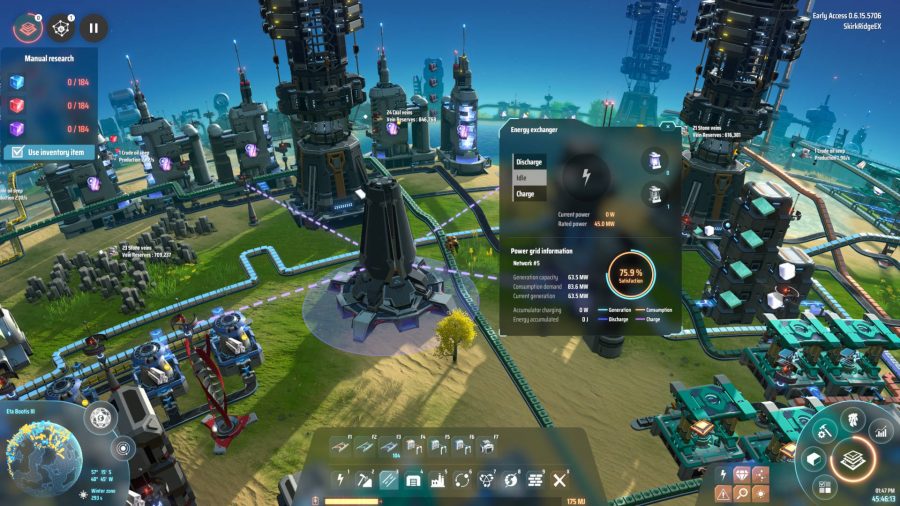
How to transfer power between planets
Speaking of things to do in the long run, it is possible to generate electricity on one planet, ship the captured energy via accumulators, then use an extractor to inject another planet’s power supply with those full accumulators. Since power is not shared between planets, this is a vital step to fully automating your operation. Here are the tech tree requirements:
- Interstellar power transmission: 1,200 electromagnetic matrix, 1,200 energy matrix, 120 structure matrix
- Energy storage: 600 electromagnetic matrix, 600 energy matrix
- Interstellar logistics system: 1,200 electromagnetic matrix, 1,200 energy matrix, 120 structure matrix
A key thing to note is that you must be generating surplus power to your base in order to charge the accumulators needed to transport energy over. To transfer energy from one planet to another, you will need to follow these exact steps:
- Construct two interstellar logistics towers and enough logistics vessels to transport energy
- Make two energy exchangers, one for the planet you’re generating power from and one that you’re transferring energy to
- Run some conveyor belts between each tower and each exchanger. You’ll want two tracks, leading to and away from the exchanger
- Set the filters on both sets of tracks. You want the charging exchanger to have empty accumulators going in and full ones going outbound, and vice versa for the extracting exchanger
- Set the exchanger where you wish to charge the energy to ‘Charge’, then put empty accumulators inside of it
- Set the exchanger where you wish to extract the energy to ‘Discharge’. It will automatically take the power from full accumulators that go into it
Every fuel type power level in Dyson Sphere Program
Different power sources generate varying rates of electricity when placed in a relevant power station or generator. Some generate a miniscule amount of energy that will be burned through in seconds, while others generate enough to keep a base going for a long time. Each resource has an associated energy generation value in joules. For the unfamiliar, the value of a joule is measured much like hard drive space on a computer, so a one gigajoule power source lasts much longer than 500 kilojoules.
Each fuel also has what is known as the Fuel Chamber Generation value, or FCG for short. This is how much power the fuel source generates when you place it inside your mech (press C to open up the mech, then drag the fuel source into your mech).
Since you’re here: Here are the best space games on PC
The FCG either adds or subtracts a percentage from the power level of the resource, depending on the conversion rate. For example, the FCG of plant fuel is -30%, so it takes 30% away from the 500KJ the plant fuel would normally generate, giving you only 350KJ of power per unit. It can also add power too, so hydrogen fuel rods add 200% to the 40MJ each one produces to give 120MJ per unit.
We’ve popped the full list of resources and how much energy they generate in both power stations and your mech below, even converting the power output for each:
| Fuel type | Energy generated (power station) | FCG (Conversion rate) | Energy generated (mech) |
| Plant fuel | 500KJ | -30% | 350KJ |
| Log | 1.5MJ | -10% | 1.35MJ |
| Organic crystal | 1.8MJ | -20% | 1.44MJ |
| Coal | 2.7MJ | 0% | 2.7MJ |
| Energetic graphite | 6.3MJ | +60% | 10.08MJ |
| Crude oil | 4MJ | +20% | 4.8MJ |
| Refined oil | 4.4MJ | +30% | 5.72MJ |
| Hydrogen | 8MJ | +100% | 16MJ |
| Deuterium | 8MJ | +100% | 16MJ |
| Diamond | 900KJ | -50% | 450KJ |
| Graphene | 96KJ | -70% | 28.8KJ |
| Carbon nanotube | 84KJ | -80% | 16.8KJ |
| Fire ice | 4.8MJ | +40% | 6.72MJ |
| Hydrogen fuel rod | 40MJ | +200% | 120MJ |
| Deuterium fuel rod | 600MJ | +300% | 2.4GJ |
| Antimatter fuel rod | 7.5GJ | +500% | 45GJ |
| Full accumulator | 90MJ | +100% | 180MJ |
And that’s all you need to know about power in Dyson Sphere Program. As long as you keep building on your power sources, you’ll be able to run your base effectively, and will be able to power your operations no matter which planet you end up on. If you’re looking for tips on logistics, our Dyson Sphere Program guide has an entire section dedicated to moving goods around. We also have a guide to help you look for Dyson Sphere Program titanium, the principles of which can be applied to other rare resources on other planets.
